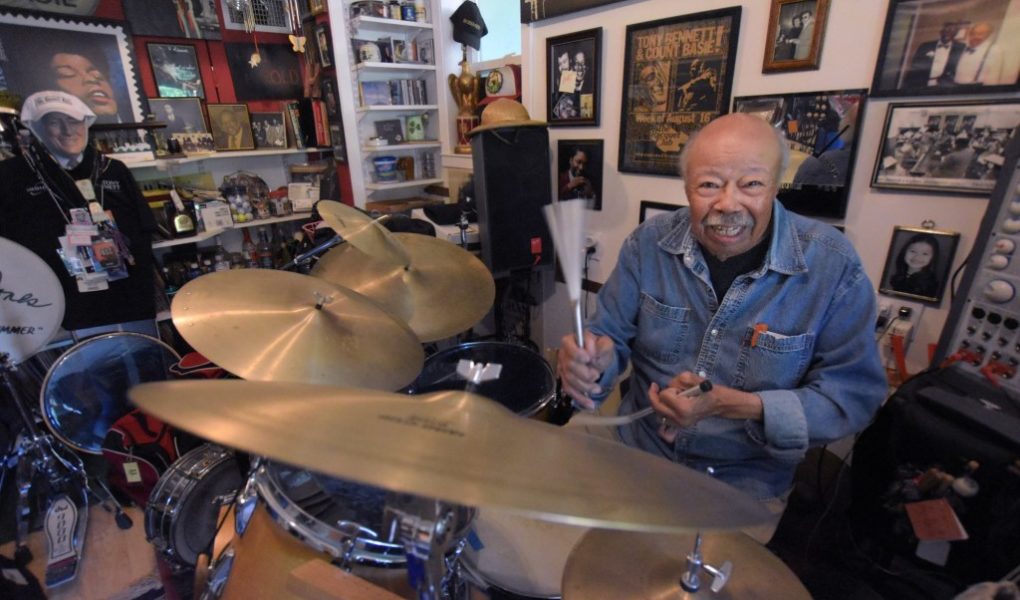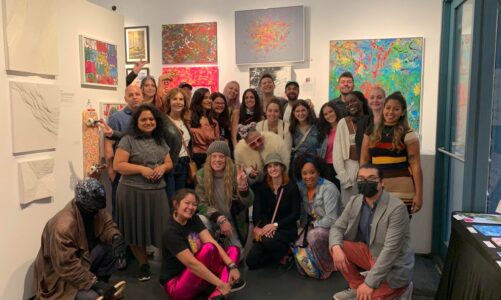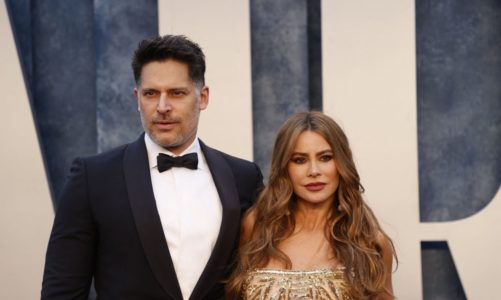Behind a curtain in Harold Jones’ Woodacre home is what he calls his “hall of fame” — and for good reason.
That’s where he hangs his multi-platinum record for playing drums on Natalie Cole’s 1991 comeback album, the smash hit “Unforgettable.”
In the hallway are framed Grammy Award certificates for Jones’ work on Tony Bennett’s “Cheek to Cheek” and “Love for Sale” albums with Lady Gaga, and for Bennett’s collaboration with Stevie Wonder on the song “For Once in My Life.”
Among snapshots of Jones with former presidents Bill Clinton and Ronald Reagan, a photo portrait of the revered Count Basie, the legendary big bandleader who helped launch Jones’ seven-decade career, smiles down from an honored place on the wall.
Still chipper and spry at 83, Jones has kept the beat for many of the finest jazz and pop vocalists of the past century, a starry class that includes Sarah Vaughan, Ella Fitzgerald, Nancy Wilson, Judy Garland, Bing Crosby and Sammy Davis Jr., earning him the unofficial title of “the singer’s drummer.” Natalie Cole once called him “the best jazz drummer in the world.”
Asked what being a singer’s drummer entails, Jones smiles as he explains, “It means you don’t step on any words. You know how to swing and support, and you do not overshadow the singer.”
For the past 20 years, Jones toured and recorded with Bennett, the onetime heir apparent to Frank Sinatra, who died July 21 at age 96 after a seven-year struggle with Alzheimer’s disease. For Jones, losing Bennett, whom he’d known since 1968, was more than losing a gig, a meal ticket, a paycheck. He’d also lost a friend.
“It was absolutely heartbreaking,” says Jones, before pointing out a framed pencil sketch in his living room that the singer, an accomplished painter and visual artist, drew of him one night while they were having dinner together on the road.
For Jones, his relationship with his famous employer was more than just business. During breaks from touring, Bennett (given name Anthony Dominick Benedetto) visited him and his second wife, Denise, a retired caterer, in Woodacre a couple of times over the years. One night, she made him lasagna from his mother’s secret recipe.
“He said it was the best he’d ever had since his mom’s,” Jones says.
Facing racism
In his long career, which began during the days of the Jim Crow South, Jones experienced the humiliation of racism, which he talks about in “The Musicians’ Green Book: An Enduring Legacy,” a recent PBS documentary about the guide book to the restaurants and hotels that served and accommodated Black artists when they were traveling during the era of segregation.
“The Green Book” came in handy when Jones was a young member of the Paul Winter Sextet, an integrated group that won a collegiate jazz band contest and performed at the White House for the Kennedys in 1962 before embarking on a U.S. State Department good will tour of 25 countries.
“They flew us down to Miami before we were going to leave,” Jones remembers. “All six of us couldn’t stay in the same hotel because there were three Whites and three Blacks in the band. Here we were, getting ready to represent our country all over the world, and we couldn’t stay in the same hotel in Miami.”
As a boy growing up in Richmond, Indiana, Jones began playing drums at a summer music camp that his mother insisted he attend. At the camp, he was taught to read music, a skill that would serve him well over the years, landing him gigs in clubs and shows and with bands that required it. He was only 14 then, and you could say he had an affinity for percussion. A year later, he was playing with jazz guitarist Wes Montgomery.
After high school, he won a full scholarship to the American Conservatory of Music in Chicago, but racism put an end to his classical ambitions.
“I went there thinking I was going to want to play symphony music,” he remembers. “I was ushering at Orchestra Hall in Chicago and was told that minorities could not play in the orchestra. That was the rule. I was playing all these nights in clubs in Chicago, so I said, ‘I don’t need to play with the symphony.’ That’s what put me into jazz.”
As a top echelon Black musician, Jones had a personal admiration and appreciation for Bennett’s activism in the civil rights movement.
“He marched with Martin Luther King and Harry Belafonte,” Jones says. “Very few people know that because Tony didn’t brag about himself. Not at all. He not only put his money where his mouth was, he put his life on the line. He did those kinds of things and then kept going in his own way.”
Big break with Basie
Jones’ big break came in 1967, when he joined the Basie Band for a week of holiday shows, beginning on Christmas Eve, in the Rainbow Room atop the Empire State Building in Manhattan. Hired as a fill-in for the regular drummer, Jones got the job because he was the only available drummer around who could read music.
Making good money playing every night in Chicago clubs, he took a pay cut to go with Basie, but the tradeoff — the exposure and experience he gained with a band of that stature — was worth it. He would go on to play in that 17-piece big band for five years.
“Nobody didn’t like Count Basie,” he says. “I learned something new every night.”
After Basie, Jones played for a decade with two-time Grammy-winning jazz singer Sarah Vaughan, aka “Sassy” or “the divine one.” She struggled with financial issues and management problems, Jones remembers, and died in 1990 of lung cancer at age 66.
“I was with her for the last 10 years of her life,” he says. “She had five managers in those 10 years because every other year she’d discover what he had stolen the year before. Sarah would give you the shirt off her back. And a year later, waiting for a plane at the airport, she’d say, ‘Hey remember that shirt I gave you? I left two dollars in the pocket.’”
While playing with Vaughan in Los Angeles, Jones met Denis Jones through his brother, Melvyn “Deacon” Jones, organ player for bluesman John Lee Hooker. In Los Angles, she was selling T-shirts for Hooker’s band, and Jones offered to give her a ride back to her home in Woodacre, the same woodsy creekside house where they live today, 42 years later.
They were married at the San Geronimo Golf Club in 1982, had their wedding reception backstage at Davies Symphony Hall after a Sarah Vaughan/Count Basie concert and spent their honeymoon on tour with the band.
“She takes care of all the little stuff, and I take care of all the big stuff,” Jones says of his wife, adding with a laugh: “In 40 years, nothing big has come up.”
When he wasn’t on the road, Jones would occasionally perform with a big band of local musicians on Sunday afternoons at the golf club. Two local jazz fans, Joe Agro and Gil Jacobs, co-authored his biography, “Harold Jones: the Singer’s Drummer,” published in 2011.
Career capstone
Jones met Bennett in 1968 when he would be featured as a guest vocalist with Count Basie’s band. The singer’s career had been at its height in the 1950s and early ’60s. He had his first No. 1 hit, “Because of You,” in 1951. It was reportedly the last song he sang to his wife, a cappella, before he died. He recorded his signature song, “I Left My Heart in San Francisco,” in 1962, which would gain a worldwide audience and endear him to generations of Bay Area music fans. It’s still played today after every winning San Francisco Giants home game.
By the late ’60s, though, his star was fading, dimmed by the dominance of rock ‘n’ roll.
“They tried to get Tony to sing rock, but he didn’t change,” Jones recalls. “I never got into playing rock, either. After we met, Tony would know when the band wasn’t working and I was sitting around in New York. He would come get me and we would fly down to Miami to play the Copacabana for the weekend, or to the Fairmont in San Francisco. Tony had his million selling hits, but he didn’t have many gigs.”
Bennett stuck to his guns, though, and made a comeback in the ’80s and ’90s. Jones joined him full-time in 2003, a prestigious job that would turn out to be a fulfilling capstone to his career.
“Tony was very generous,” Denise Jones says. “He had a private plane and if they were going to Europe and the wives wanted to go, he got a bigger plane. We could go anywhere with them. On the wives’ birthdays, he’d send us flowers. He gave major generous Christmas bonuses. He was perfect. Everyone should be like that.”
Bennett’s late-life resurgence was supercharged when he was joined by Lady Gaga, the mega pop star who re-invented herself as a jazz singer at Bennett’s urging, on two top 10 albums “Cheek to Cheek” in 2014 and “Love for Sale,” which would be Bennett’s last, in 2021.
At first, Jones was suspicious of Lady Gaga’s motives, but she won him over.
“I was thinking, ‘Oh, this hot dog. She’s just in it for the glory,’” he recalls. “But no. She treated him like he was her grandfather. She treated him with total respect at all times.”
It turned out to be a collaboration that benefitted them both.
“They were good for each other,” Jones says. “He’d give her a touch of class, and she’d give him her audience. I’ve never seen so many young people around the hotel waiting to see us come out. That didn’t happen before Gaga.”
‘It amazed us all’
Despite all the unexpected success, it was painful for Jones to watch his old friend’s inexorable decline after the Alzheimer’s diagnosis in 2016. It got so bad toward the end that the singer couldn’t recognize him or the other musicians in his band, let alone remember their names.
“Five years ago, he didn’t know who I was,” Jones says. “The man couldn’t find his dressing room.”
At the same time, though, from behind his drum kit, Jones would be a part of what was perhaps the most miraculous final act in pop music history.
After being sidelined by the pandemic for two years, Bennett, Lady Gaga and the band came together for what would be Bennett’s final live performances, a pair of concerts at Radio City Music Hall in August 2021.
Bennett could no longer remember anyone’s name. How was he going to remember the lyrics to dozens of songs? The Radio City shows were preceded by a tense trial run for “MTV Unplugged,” a series of three run-throughs over two days in studio set up like a club with the stage in the round and an audience of just 75 friends and family. No press was allowed.
“As a drummer, I was sitting up there with a stick in the air, and didn’t know whether to hit it or not, afraid that he might freeze at any moment,” Jones remembers. “But he never did. This man was going out on stage, even right up to the last show we did at Radio City Music Hall with Lady Gaga, and he could remember the words to 35 songs and sing them with feeling and with passion. It amazed us all.”
During the tune “Night and Day,” Lady Gaga gave Jones props from the stage, calling him Tony Bennett’s and Count Basie’s favorite drummer.
These days, the ever-upbeat octogenarian still looks forward to performing when the opportunity arises. As he says, “When you’re playing music, everything is beautiful. You’re a rich man.”
Contact Paul Liberatore at p.liberatore@comcast.net
𝗖𝗿𝗲𝗱𝗶𝘁𝘀, 𝗖𝗼𝗽𝘆𝗿𝗶𝗴𝗵𝘁 & 𝗖𝗼𝘂𝗿𝘁𝗲𝘀𝘆: www.mercurynews.com
𝗙𝗼𝗿 𝗮𝗻𝘆 𝗰𝗼𝗺𝗽𝗹𝗮𝗶𝗻𝘁𝘀 𝗿𝗲𝗴𝗮𝗿𝗱𝗶𝗻𝗴 𝗗𝗠𝗖𝗔,
𝗣𝗹𝗲𝗮𝘀𝗲 𝘀𝗲𝗻𝗱 𝘂𝘀 𝗮𝗻 𝗲𝗺𝗮𝗶𝗹 𝗮𝘁 dmca@enspirers.com








